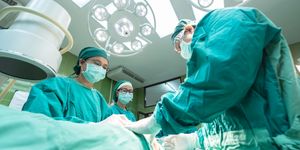How Good Are At-Home COVID Tests at Detecting the Virus When You're Contagious?
Some of us may have heard stories of family and friends who all tested negative on at-home rapid antigen tests before a New Year's party, got together, and then came down with symptoms of COVID the next day. Or for those at workplaces with frequent testing, we may know of someone who tested negative one day and then positive the next once symptoms appeared. Both realities beg the question: Are these tests that are supposed to be giving us peace of mind in not spreading SARS-CoV-2 actually missing it when we're contagious?
The CDC in their December 27th press release stated they were shortening their recommended isolation period to 5 days because SARS-CoV-2 transmission was found to generally occur 1 to 2 days prior to onset of symptoms and 2 to 3 days after. A recent study under peer review found that FDA-approved rapid antigen tests Abbott BinaxNOW and Quidel QuickVue, however, lagged behind in detecting COVID when people were indeed positive and able to transmit the virus.
This study gathered data from 30 people in New York and San Francisco whose workplaces required they test daily for COVID with both antigen and PCR tests. PCR tests, the more sensitive test whose results take longer because they're sent to labs, allowed researchers to confirm that these people were infected with COVID before the rapid antigen tests detected it. All antigen tests took nearly two days after an initial positive PCR test before reading positive, and in 28 of the 30 cases, the level of virus detected on the initial PCR test was considered high enough to infect other people. COVID transmission was actually confirmed to have occurred in four cases before antigen tests detected the virus.
In every case, though, the rapid antigen tests did eventually detect the virus.
As Kevin Dieckhaus, Chief of Infectious Diseases at UConn Health explains, “The antigen tests really require a high level of virus in order to test positive, and sometimes it takes a couple of days for that really to hit the threshold for that test to test positive.”
In a Senate Health Committee hearing, FDA Commissioner Dr. Janet Woodcock confirmed, "We do know the tests are picking up Omicron but with less sensitivity."
These antigen tests use nasal swabs to try and detect the virus. Omicron, however, is suspected to appear in the throat before the nose, leading people to wonder if throat swabs for antigen tests may be better at detecting the virus. Despite the UK's National Health Service and the Israeli Health Ministry recommending swabbing the nose and throat for increasing antigen test sensitivity, the FDA continues to discourage it. Their reasons – gagging and difficulty getting a good sample. Melissa Miller, chair of the American Society for Microbiology's clinical and public health microbiology committee, adds that food and drink residue in the throat could potentially cause a false positive test.
So with Omicron, whether symptomatic or not, your negative at-home COVID test doesn't necessarily mean you're not infected and contagious. It may take more than a day since symptoms started and multiple tests before one reads positive.
Sources: Stat, MedRxIV, MSN Health, NBC, CDC










